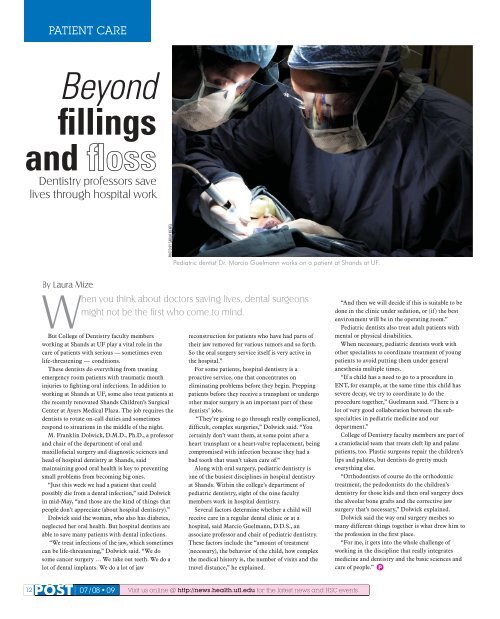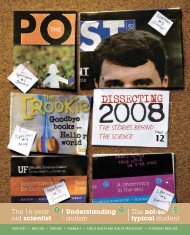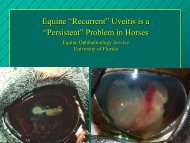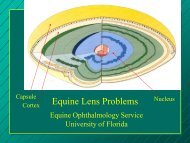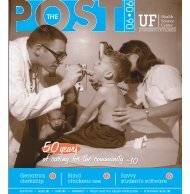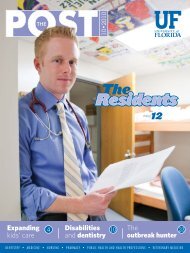no place - UF Health Podcasts - University of Florida
no place - UF Health Podcasts - University of Florida
no place - UF Health Podcasts - University of Florida
- No tags were found...
You also want an ePaper? Increase the reach of your titles
YUMPU automatically turns print PDFs into web optimized ePapers that Google loves.
PATIENT CAREBeyondfillingsandDentistry pr<strong>of</strong>essors savelives through hospital workPHOTO BY SARAH KIEWELPediatric dentist Dr. Marcio Guelmann works on a patient at Shands at <strong>UF</strong>.By Laura MizeWhen you think about doctors saving lives, dental surgeonsmight <strong>no</strong>t be the fi rst who come to mind.But College <strong>of</strong> Dentistry faculty membersworking at Shands at <strong>UF</strong> play a vital role in thecare <strong>of</strong> patients with serious — sometimes evenlife-threatening — conditions.These dentists do everything from treatingemergency room patients with traumatic mouthinjuries to fighting oral infections. In addition toworking at Shands at <strong>UF</strong>, some also treat patients atthe recently re<strong>no</strong>vated Shands Children’s SurgicalCenter at Ayers Medical Plaza. The job requires thedentists to rotate on-call duties and sometimesrespond to situations in the middle <strong>of</strong> the night.M. Franklin Dolwick, D.M.D., Ph.D., a pr<strong>of</strong>essorand chair <strong>of</strong> the department <strong>of</strong> oral andmaxill<strong>of</strong>acial surgery and diag<strong>no</strong>stic sciences andhead <strong>of</strong> hospital dentistry at Shands, saidmaintaining good oral health is key to preventingsmall problems from becoming big ones.“Just this week we had a patient that couldpossibly die from a dental infection,” said Dolwickin mid-May, “and those are the kind <strong>of</strong> things thatpeople don’t appreciate (about hospital dentistry).”Dolwick said the woman, who also has diabetes,neglected her oral health. But hospital dentists areable to save many patients with dental infections.“We treat infections <strong>of</strong> the jaw, which sometimescan be life-threatening,” Dolwick said. “We dosome cancer surgery … We take out teeth. We do alot <strong>of</strong> dental implants. We do a lot <strong>of</strong> jawreconstruction for patients who have had parts <strong>of</strong>their jaw removed for various tumors and so forth.So the oral surgery service itself is very active inthe hospital.”For some patients, hospital dentistry is aproactive service, one that concentrates oneliminating problems before they begin. Preppingpatients before they receive a transplant or undergoother major surgery is an important part <strong>of</strong> thesedentists’ jobs.“They’re going to go through really complicated,difficult, complex surgeries,” Dolwick said. “Youcertainly don’t want them, at some point after aheart transplant or a heart-valve re<strong>place</strong>ment, beingcompromised with infection because they had abad tooth that wasn’t taken care <strong>of</strong>.”Along with oral surgery, pediatric dentistry isone <strong>of</strong> the busiest disciplines in hospital dentistryat Shands. Within the college’s department <strong>of</strong>pediatric dentistry, eight <strong>of</strong> the nine facultymembers work in hospital dentistry.Several factors determine whether a child willreceive care in a regular dental clinic or at ahospital, said Marcio Guelmann, D.D.S., anassociate pr<strong>of</strong>essor and chair <strong>of</strong> pediatric dentistry.These factors include the “amount <strong>of</strong> treatment(necessary), the behavior <strong>of</strong> the child, how complexthe medical history is, the number <strong>of</strong> visits and thetravel distance,” he explained.“And then we will decide if this is suitable to bedone in the clinic under sedation, or (if) the bestenvironment will be in the operating room.”Pediatric dentists also treat adult patients withmental or physical disabilities.When necessary, pediatric dentists work withother specialists to coordinate treatment <strong>of</strong> youngpatients to avoid putting them under generalanesthesia multiple times.“If a child has a need to go to a procedure inENT, for example, at the same time this child hassevere decay, we try to coordinate to do theprocedure together,” Guelmann said. “There is alot <strong>of</strong> very good collaboration between the subspecialtiesin pediatric medicine and ourdepartment.”College <strong>of</strong> Dentistry faculty members are part <strong>of</strong>a crani<strong>of</strong>acial team that treats cleft lip and palatepatients, too. Plastic surgeons repair the children’slips and palates, but dentists do pretty mucheverything else.“Orthodontists <strong>of</strong> course do the orthodontictreatment, the pedodontists do the children’sdentistry for those kids and then oral surgery doesthe alveolar bone grafts and the corrective jawsurgery that’s necessary,” Dolwick explained.Dolwick said the way oral surgery meshes somany different things together is what drew him tothe pr<strong>of</strong>ession in the first <strong>place</strong>.“For me, it gets into the whole challenge <strong>of</strong>working in the discipline that really integratesmedicine and dentistry and the basic sciences andcare <strong>of</strong> people.” PPOST07 / 08 • 0912 POSTVisit us online @ http://news.health.ufl.edu for the latest news and HSC events.


